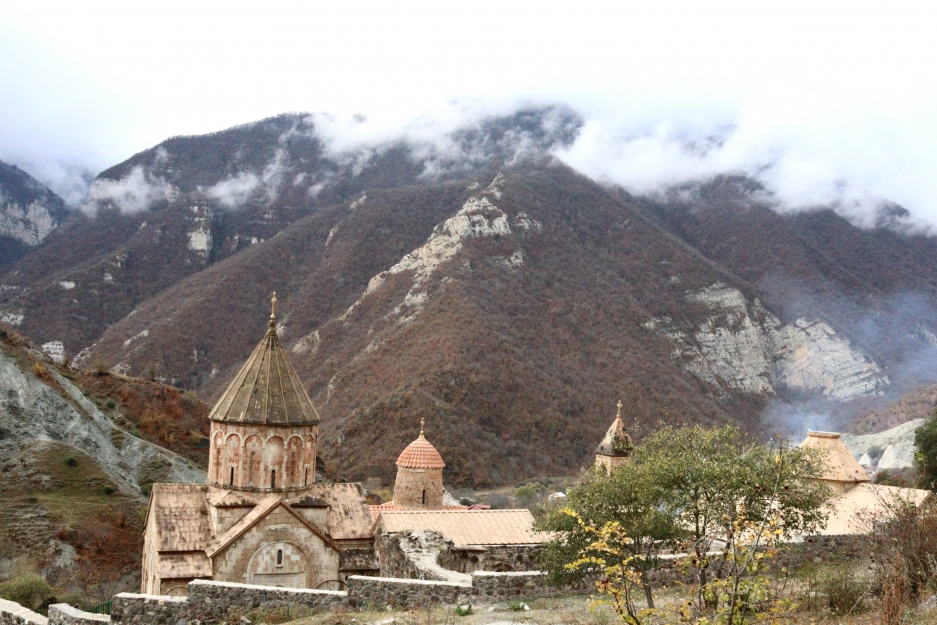Azerbaijan has demanded the expulsion of the Armenian clergy from the Dadivank monastery in disputed Nagorno-Karabakh

In the context of the current blockade by Azerbaijan on the Republic of Artsakh, the ethnic Armenian breakaway state in the Nagorno-Karabakh region, the Armenian Christians are suffering increasing threats and fear for their future. In one of the latest threats against the Christians living in the region, Azerbaijan has demanded the expulsion of the Armenian clergy from the Dadivank monastery, built in the 9th century and one of the symbols of medieval Armenia.
"Armenian priests in Khudavang Monastery [i.e., Dadivank Monastery] should leave there," said the chairman of the Azerbaijani State Committee for Work with Religious Organizations, Mubariz Gurbanli, to Azeri-Press Agency (APA) on May 4. He also claims that Armenians have no ties to the monastery, as it "was established in Caucasian Albania¹ and will eventually be run by the Albanian-Udi religious community."
This statement was condemned by the Artsakh authorities, which warned that Azerbaijan is carrying a policy of "Albanisation"¹ of the Armenian historical and religious heritage, trying to erase all traces of the millennia-old Armenian presence in Artsakh and promoting pseudo-historical theses to justify the destruction and transformation of the Armenian monuments. The Mother See of Holy Etchmiadzin replied to the Azerbaijani statements stating that Armenian priests continue their spiritual service in Dadivank thanks to Russian peacekeepers.
The Dadivank Monastery, built between the 9th and 13th centuries, is one of the symbols of the Armenian people, the first-ever Christian nation. Since the end of the Second Nagorno-Karabakh War in 2020 achieved by the trilateral ceasefire agreement between Armenia, Azerbaijan, and Russia, the Azerbaijani side has been constantly pushing the boundaries of the ceasefire and capturing more territory from Artsakh and even from the recognized sovereign territory of Armenia.
The monastery fell in a territory taken by Azerbaijan, but under the protection of Russian peacekeepers, the Armenian Apostolic Church continued to hold services there. Azerbaijan unilaterally closed the monastery's entry to Armenian Christians in the spring of 2021 after cutting ties with the Russian peacekeeping force. In December 2022 Azerbaijan started a blockade cutting Artsakh from the rest of the World to pressure for the ethnic removal of Armenians from the region.
To achieve the objective of erasing any Armenian trace from Nagorno-Karabakh, Azerbaijan needs more than military means. The region has been long populated by the Armenian people (at least around the 3rd century BC) and it's one of its historical regions. As the old Armenian presence is proven by the churches, monasteries, monuments and different cultural and religious heritage pieces, Azerbaijan started a campaign of historical revisionism claiming that these were but Armenian but Albanian.¹
The recent demand for the expulsion of the Armenian clergy from the Dadivank monastery is only one case in a large number of recorded attacks on the Christian religion of Armenia, in violation of the ceasefire agreement, the ICJ ruling of 7 December 2021 and basic freedom of religion.
¹ Albania or Caucasian Albania is a historical region of the eastern Caucasus that existed on the land of present-day Azerbaijan and partially southern Dagestan. The Armenian Apostolic Church assumed jurisdiction over the Caucasus Albania Church in 705.
Sources: Armenpress; NEWS.am; 301
Photo by Meline Asryan